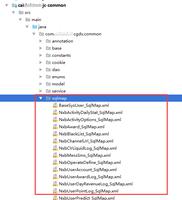@Autowired @Resource用法
本文内容纲要:
- @Autowired的用法和作用- @Resource的作用和用法
@Autowired的用法和作用
这个注解就是spring可以自动帮你把bean里面引用的对象的setter/getter方法省略,它会自动帮你set/get。
<bean id="userDao"class="..."/>
<bean id="userService"class="...">
这样你在userService里面要做一个userDao的setter/getter方法。
但如果你用了@Autowired的话,你只需要在UserService的实现类中声明即可。
@Autowired
private IUserDao userdao;
Spring@Autowired注解与自动装配
1 配置文件的方法
我们编写spring 框架的代码时候。一直遵循是这样一个规则:所有在spring中注入的bean 都建议定义成私有的域变量。并且要配套写上 get 和 set方法。
Boss 拥有 Office 和 Car 类型的两个属性:
- Boss.java
public class Boss {
private Car car;
private Office office;
// 省略 get/setter
@Override
public String toString() {
return "car:" + car + "/n" + "office:" +office;
}
}
我们在 Spring 容器中将 Office 和 Car 声明为 Bean,并注入到 Boss Bean 中:下面是使用传统 XML 完成这个工作的配置文件 beans.xml:
beans.xml 将以上三个类配置成 Bean
<beansxmlns="http://www.springframework.org/schema/beans"
xmlns:xsi="http://www.w3.org/2001/XMLSchema-instance"
xsi:schemaLocation="http://www.springframework.org/schema/beans
http://www.springframework.org/schema/beans/spring-beans-2.5.xsd">
<bean id="car" class="Car"scope="singleton">
<property name="brand"value=" 红旗 CA72"/>
当我们运行以下代码时,控制台将正确打出 boss 的信息:
清单 5. 测试类:AnnoIoCTest.java
import org.springframework.context.ApplicationContext;
importorg.springframework.context.support.ClassPathXmlApplicationContext;
public class AnnoIoCTest {
public static void main(String[] args) {
String[] locations = {"beans.xml"};
ApplicationContext ctx =
new ClassPathXmlApplicationContext(locations);
Boss boss = (Boss) ctx.getBean("boss");
System.out.println(boss);
}
}
这说明 Spring 容器已经正确完成了 Bean 创建和装配的工作。
- @Autowired
Spring 2.5 引入了 @Autowired 注释,它可以对类成员变量、方法及构造函数进行标注,完成自动装配的工作。通过 @Autowired的使用来消除 set ,get方法。
要实现我们要精简程序的目的。需要这样来处理:
在applicationContext.xml中加入:
<beanclass="org.springframework.beans.factory.annotation.AutowiredAnnotationBeanPostProcessor"/>
Spring 通过一个BeanPostProcessor 对 @Autowired 进行解析,所以要让 @Autowired 起作用必须事先在 Spring 容器中声明 AutowiredAnnotationBeanPostProcessor Bean。
修改在原来注入spirng容器中的bean的方法。
在域变量上加上标签@Autowired,并且去掉相应的get 和set方法
使用 @Autowired 注释的 Boss.java
importorg.springframework.beans.factory.annotation.Autowired;
public class Boss {
@Autowired
private Car car;
@Autowired
private Office office;
}
在applicatonContext.xml中把原来 引用的
<beansxmlns="http://www.springframework.org/schema/beans"
xmlns:xsi="http://www.w3.org/2001/XMLSchema-instance"
xsi:schemaLocation="http://www.springframework.org/schema/beans
http://www.springframework.org/schema/beans/spring-beans-2.5.xsd">
<bean class="org.springframework.beans.factory.annotation.
AutowiredAnnotationBeanPostProcessor"/>
<bean id="car" class=" Car"scope="singleton">
这样,当 Spring 容器启动时,AutowiredAnnotationBeanPostProcessor将扫描 Spring 容器中所有 Bean,当发现 Bean 中拥有 @Autowired 注释时就找到和其匹配(默认按类型匹配)的 Bean,并注入到对应的地方中去。
按照上面的配置,Spring 将直接采用 Java 反射机制对 Boss 中的 car 和 office 这两个私有成员变量进行自动注入。所以对成员变量使用 @Autowired 后,您大可将它们的 setter 方法(setCar() 和 setOffice())从 Boss 中删除。
当然,您也可以通过 @Autowired 对方法或构造函数进行标注,如果构造函数有两个入参,分别是 bean1 和 bean2,@Autowired 将分别寻找和它们类型匹配的 Bean,将它们作为 CountryService (Bean1 bean1 ,Bean2 bean2) 的入参来创建CountryService Bean。来看下面的对方法
public class Boss {
private Car car;
private Office office;
@Autowired
public void setCar(Car car) {
this.car = car;
}
@Autowired
public void setOffice(Office office) {
this.office = office;
}
…
}
这时,@Autowired 将查找被标注的方法的入参类型的 Bean,并调用方法自动注入这些 Bean。而下面的使用方法则对构造函数进行标注:
public class Boss {
private Car car;
private Office office;
@Autowired
public Boss(Car car ,Office office){
this.car = car;
this.office = office ;
}
}
由于 Boss() 构造函数有两个入参,分别是 car 和 office,@Autowired 将分别寻找和它们类型匹配的 Bean,将它们作为 Boss(Car car ,Office office) 的入参来创建 Boss Bean。
@Resource的作用和用法
@Resource 的作用相当于 @Autowired,只不过 @Autowired 按 byType 自动注入,面 @Resource 默认按 byName自动注入罢了。
@Resource 有两个属性是比较重要的,分别是 name和 type,Spring将 @Resource 注释的 name属性解析为 Bean的名字,
而 type属性则解析为 Bean的类型。所以如果使用 name属性,则使用 byName的自动注入策略,而使用 type属性时则使用 byType
自动注入策略。如果既不指定 name也不指定 type属性,这时将通过反射机制使用 byName自动注入策略。
Resource 注释类位于 Spring发布包的 lib/j2ee/common-annotations.jar类包中,因此在使用之前必须将其加入到项目的类库中。
来看一个使用 @Resource 的例子:
使用 @Resource注释的 Boss.java
importjavax.annotation.Resource;
public class Boss{
// 自动注入类型为 Car 的 Bean
@Resource
private Car car; // 自动注入 bean 名称为 office 的 Bean
@Resource(name = "office")
private Office office;
}
一般情况下,我们无需使用类似于 @Resource(type=Car.class) 的注释方式,因为 Bean 的类型信息可以通过 Java反射从代码中获取。
要让 JSR-250 的注释生效,除了在 Bean 类中标注这些注释外,还需要在 Spring容器中注册一个负责处理这些注释的BeanPostProcessor:
CommonAnnotationBeanPostProcessor 实现了 BeanPostProcessor 接口,它负责扫描使用了 JSR-250 注释的 Bean,并对它们进行相应的操作。
本文内容总结:@Autowired的用法和作用,@Resource的作用和用法,
原文链接:https://www.cnblogs.com/lijia0511/p/5751883.html
以上是 @Autowired @Resource用法 的全部内容, 来源链接: utcz.com/z/296418.html



